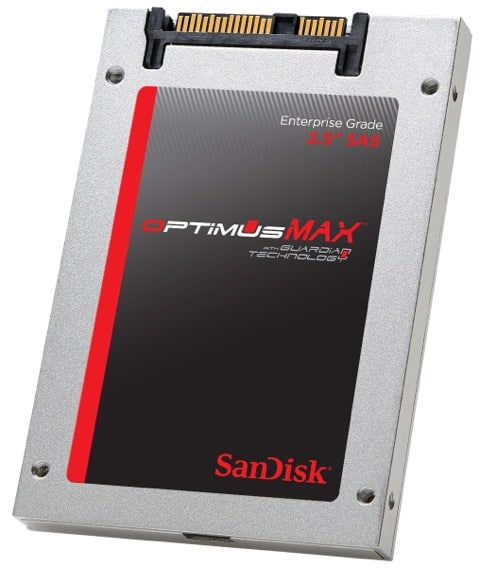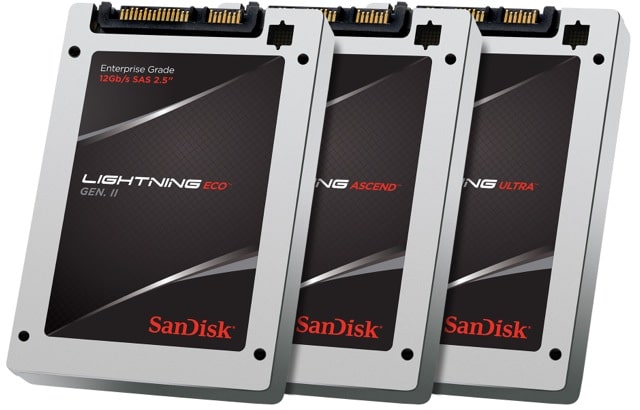
Hot on the heels of refreshing their enterprise SATA SSD line, SanDisk is updating their entire SAS offering with several new announced drives including the 4TB Optimus Max, Lightning Gen. II 12Gb/s SAS SSDs, and entire the Optimus product family, extending SanDisk’s entire SAS portfolio to cover the performance, capacity and endurance needs of a wide array of enterprise applications. The most important drive that was announced is SanDisk’s new Optimus Max 4TB flash drive, which is double the capacity of the current largest SSDs on the market all the while delivering SAS performance and features all at the cost of SATA SSD-like prices for enterprise, cloud, and virtualized data centers. This massive 4TB SSD gives organizations the ability to transition to a leaner infrastructure model, for maximum total cost of ownership.
The Optimus Max SSD is optimized for read-intensive application workloads including, Data Warehousing, Media Streaming, Web Servers, Video on Demand (VOD), and Web-based Applications with a typical workload comprised of a 90/10 read/write mix. This 4TB SAS SSD alleviates I/O bottlenecks by providing high-density storage for efficient data throughput to deliver, high performance, superior reliability and enhanced endurance for maximum application scalability.
In addition, the Optimus MAX 4TB SAS SSD features 19nm eMLC with a native 6Gb/s SAS interface and boasts read/write data transfer rates of up to 400MB/s and performance of up to 70,000K/15,000K IOPS random read/write. Sandisk’s new 4TB SSD can make three full drive writes a day for five years, which complements its limited 5 year warranty.
SanDisk Optimus Max Specifications:
- Interface: SAS 6Gb/s
- Interface Ports: Dual/Wide
- Sequential Read/Write: Up to 400/400 MB/s
- Random Read/Write (IOPS): Up to 70K/15K
- Capacity: 19nm eMLC* 4TB
- Sector Sizes: 512, 520, 528 byte
- Data Reliability (UBER): < 1 unrecoverable error in 1017 bits read
- MTBF: 2.5 Million Hours
- Data Fail Recovery: F.R.A.M.E. (Flexible Redundant Array of Memory Elements)
- Power Fail Recovery: EverGuard Technology: Backup Power Circuitry
- Data Path Protection: DataGuard Technology
- Warranty: The lesser of 5 years or maximum endurance used
- DWPD (Random Workload): 1 – 3 DWPD
SanDisk Lightning Gen. II 12Gb/s SAS SSDs
Also announced by SanDisk is the Lightning Gen. II 12Gb/s SAS SSD line, which is designed to provide ultra-high performance and bandwidth. The Lightning Gen II doubles the interface speed over 6Gb/s and provides high speed data transfer rates for the most cost-effective performance benefits. Additionally, it is equipped with SanDisk’s custom controller and innovative advanced parallel processing architecture to offer high availability, predictable performance, and great reliability for full data path and power loss protection. This is the next generation controller silicon, which has not been updated since SanDisk bought Pliant.
SanDisk offers three different models in the Lightning Gen II line:
- Lightning Ultra Gen. II SSDs: Designed for write-Intensive application workloads (SLC); high endurance for the analysis of large data sets. This lowers a data center’s TCO at 25 full Drive Writes Per Day.
- Lightning Ascend Gen. II SSDs: Designed for mixed-use application workloads (eMLC); high speed data transfer rates at 10 full Drive Writes Per Day.
- Lightning Eco Gen. II SSDs: Designed for read-intensive application workloads (eMLC); high read throughput and low latency data access for high quality of service (QoS) at 3 full Drive Writes Per Day.
Here’s a look at what the SanDisk Lightning line has to offer:
- Performance:
- 19nm SLC and eMLC 12Gb/s SAS
- Up to 1000/500-600 MB/s/ Sequential Read/Write
- Up to 190K/100K Random R/W IOPS – Lighting Ultra
- Up to 190K/80K Random R/W IOPS – Lighting Ascend
- Up to 180K/35K Random R/W IOPS – Lighting Eco
- Endurance and capacities:
- 200GB – 800GB – Lightning Ultra – Write-Intensive
- 200GB – 1.6TB – Lightning Ascend – Mixed-Use
- 1TB – 1.6TB – Lightning Eco – Read-Intensive
- 25 DWPD (Random Workload) – Lighting Ultra
- 10 DWPD (Random Workload) – Lightning Ascend
- 3 DWPD (Random Workload) – Lightning Eco
- 5 Year Limited Warranty
- Reliability:
- Full Data Path Protection (T10-DIF Support)
- SED – Instant Secure Erase
- MTBF – 2.5 Million Hours
SanDisk Optimus 6Gb/s SAS SSDs
Lastly, SanDisk has announced a refreshed Optimus 6Gb/s SAS SSD Product Family with four new SanDisk 19nm eMLC workload-optimized SSDs for the data center. With this update, SanDisk shows us that the Optimus SSD line delivers a single SAS platform that can address a wide range of enterprise application performance, capacity and endurance requirements:
- Optimus Extreme SSDs: Write-Intensive application workloads – designed for ultra-high endurance for financial transactions and big data analytics at 45 full Drive Writes per Day
- Optimus Ultra SSDs: Write-Intensive application workloads – designed with high endurance for the analysis of large data sets at 25 full Drive Writes per Day
- Optimus Ascend SSDs: Mixed-Use application workloads with high speed data transfer rates at 10 full Drive Writes per Day with a 5 year warranty
- Optimus Eco SSDs: Mixed-Use and Read-Intensive application workloads – that include OLTP, Email/Messaging and Financial Transactions to high read throughput for media streaming with 1 – 3 full Drive Writes per Day
The Optimus SSDs include SanDisk’s proprietary Guardian Technology Platform, which is comprised of FlashGuard, DataGuard and EverGuard technologies, which collaborate together to provide a combination of powerful error correction and detection technology, full data path protection, and data fail recovery from lower cost MLC flash.
Here’s what the newly designed Optimus line has to offer:
- Performance:
- Up to 500/500 MB/s Sequential read/write
- Up to 95K/40K IOPS – Ascend, Ultra & Extreme
- Up to 90K/35K IOPS – Eco
- < 5% Performance degradation over life time
- Endurance and capacities:
- Optimus Eco: 400GB – 2TB Mixed-Use & Read-Intensive Workloads
- Optimus Ascend: 200GB – 1.6TB – Mixed-Use Workloads
- Optimus Ultra: 150GB – 1.2TB – Write-Intensive Workloads
- Optimus Extreme: 100GB – 800GB – Write-Intensive Workloads
- SanDisk 19nm eMLC / 31- 45 Full Drive Writes Per Day
- Reliability:
- Full Data Path Protection
- T10-DIF Support
- F.R.A.M.E. Technology
- Backup Power Circuitry
For more information on SanDisk's new line of enterprise SSDs, visit the product website.


